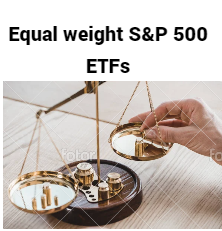
Introduction:
Imagine you’re throwing a party for your 500 closest friends.
Do you hand out all the champagne to Beyonce and Jay-Z (the Microsofts and Amazons of the party) while the rest of the gang sips soda water? Probably not. You want everyone to have a good time, right?
What Sets Equal Weight S&P 500 ETFs Apart?
Traditional S&P 500 ETFs follow a market-cap-weighted approach, meaning companies with larger market capitalizations have a greater influence on the fund’s performance. However, equal weight S&P 500 ETFs take a different approach.
Instead of giving more weight to larger companies, these ETFs assign an equal weight to each constituent, regardless of their market capitalization.
Why Equal Weighting?
The equal weight strategy is designed to provide a more balanced exposure to the entire index.
In a traditional S&P 500 ETF, a few mega-cap stocks can dominate the performance, potentially leaving smaller companies overlooked.
With equal weight S&P 500 ETFs, every company, whether large or small, gets an equal say in the fund’s performance.
This can result in a more diversified and potentially less volatile investment.
Among the multitude of ETFs, the Equal Weight S&P 500 ETF stands out as a unique and intriguing investment vehicle. In this blog post, we’ll take a closer look at what makes these ETFs special and why they might be worth considering for your portfolio.
Diversification Benefits: With equal weights, you’re not putting all your eggs in the big guys’ basket. Even a hiccup for a tech giant won’t send the whole party crashing down.
Hidden gems galore: Smaller companies get a chance to shine. You might just discover the next Google before it becomes a household name.
Reduced concentration risk: Remember those awkward high school parties where everyone clung to the popular kids? Equal weight ETFs avoid that. You’re less exposed to the ups and downs of any single company.
Potential for outperformance: Over long periods, equal weight ETFs have often matched or even outperformed their cap-weighted cousins. It’s like having a wider net and catching more fish!
Of course, no party is perfect. Here are a few things to consider:
Higher volatility: Since smaller companies can be more volatile, your equal weight ETF might take you on a bumpier ride than the traditional S&P 500.
Lower liquidity: Smaller companies might not be traded as frequently, so buying and selling your shares might take a bit longer.
Higher expense ratios: Some equal weight ETFs have slightly higher fees than their cap-weighted counterparts.
Here are five of the best equal-weight ETFs:
- Invesco S&P 500 Equal Weight ETF
- Direxion Nasdaq-100 Equal Weighted ETF
- SPDR S&P Oil & Gas Exploration & Production ETF
- Innovator S&P Investment Grade Preferred ETF
- Invesco Equal Weight 0-30 Years Treasury ETF
Finally, the choice is yours. If you’re looking for a diversified, potentially-outperforming investment with a focus on smaller companies, an equal weight S&P 500 ETF might be the perfect addition to your portfolio. Just remember, it’s still a party, so buckle up and enjoy the ride!
Conclusion: Equal weight S&P 500 ETFs offer a unique investment strategy that can appeal to investors seeking a more balanced and diversified approach to the stock market. By providing equal representation to all index constituents, these ETFs aim to reduce the influence of a few large companies, potentially leading to a more resilient and dynamic investment. As with any investment decision, it’s crucial to conduct thorough research and consider your financial goals and risk tolerance before incorporating equal weight S&P 500 ETFs into your portfolio.
Please also read our article on Gold and Silver as an investment opportunity in commodity segment.
